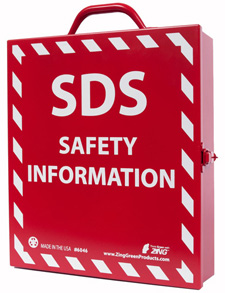



Find all of your laboratory and workplace safety supplies at Safety Emporium!
 LC50 |
 Glossary Index |
 LDLo |
| MSDS Topics |
Free Sites | FAQ's | Regulations | Glossary | Software | Suppliers |
| Books | Forum | Poll | Fun stuff | Quiz | Store | |
| Understand your MSDS with the MS-Demystifier | Search ALL our MSDS info | |||||

Get your GHS-compliant labels and signs from Safety Emporium.
An LD50 or 50% Lethal Dose value is the amount of a solid or liquid material that it takes to kill 50% of test animals (for example, mice or rats) in one dose. It is also called the median lethal dose.
This is closely related to the LDLo value which is the lowest dosage reported to have killed animals or humans.
LC50 (50% lethal concentration) is a related term used for gases, dusts, vapors, mists etc.
The dose may be administered orally (by mouth), injection into various parts of the body (intraperitoneally or intravenously), or dermally (application to the skin). The value is usually reported along with the administration method.
Both LD50 and LDLo values state the animal used in the test. This is important because animal toxicity studies do not necessarily extrapolate (extend) to humans. For example, dioxins (of Love Canal, Times Beach, Sveso and Agent Orange fame) are highly toxic to guinea pigs and ducklings at extremely low levels, but have never been unambiguously linked to a single human death even at very high levels of acute (short term) exposure; note, however they are listed by IARC as "known human carcinogens". However, it is best to err on the safe side when evaluating animal toxicity studies and assume that most chemicals that are toxic to animals are toxic to humans.
Typical units for LD50 values are milligrams or grams of material per kilogram of body weight (mg/kg or g/kg, recall that 1 kg = 2.2 pounds).

Your employees can stay informed and comply with OSHA regulations with SDS information stations and compliance products from Safety Emporium.
LC50 and LD50 values, if known, will be found on Section 11 (toxicological information) of a material's Safety Data Sheet. However, the Hazard Communication Standard does not require any testing when an SDS is created, so just because this data is missing or "not known" does not mean that the material is "safe". If no toxicity information is available, treat the material as potentially hazardous!
Never be exposed to an LD50 dose of a hazardous chemical -- by definition, there is a 50% chance this will kill you…and if you survive you're not going to be in good shape.
Of greater practical use than LC50 and LD50 is the OSHA permissible exposure level (PEL) (if the material has one). This is a more realistic determination of the maximum safe exposure to a material and is usually based on the known effects of the chemical on humans rather than laboratory animals.
See also: intraperitoneal, intravenous, LC50, mus (mouse), PEL, STEL, TLV.